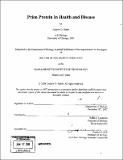Prion protein in health and disease
Author(s)
Steele, Andrew D.
DownloadFull printable version (11.79Mb)
Alternative title
PrP in health and disease
Other Contributors
Massachusetts Institute of Technology. Dept. of Biology.
Advisor
Susan L. Lindquist.
Terms of use
Metadata
Show full item recordAbstract
The prion protein (PrP) is a conserved glycoprotein tethered to cell membranes by a glycosylphosphatidylinositol anchor. In mammals, PrP is expressed in many tissues, most abundantly in brain, heart, and muscle. Importantly, PrP is required for prion diseases, which are neurodegenerative diseases associated with misfolding and aggregation of PrP. PrP can adopt a self-perpetuating conformation that templates the misfolding of normal PrP molecules into its pathogenic conformation, termed PrPsC. The role of PrPSC in the pathogenesis of prion diseases, or transmissible spongiform encephalopathies, has been studied intensively yet the mechanism by which PrP misfolding in neurons leads to injury and death remains enigmatic. Much less attention has been focused on the role of PrP in normal physiology despite the possibility that deciphering PrP's normal function could help to understand prion diseases. My thesis work has spanned both the study of the normal function of PrP and the neurotoxic pathways that are involved in prion pathogenesis. Because prion disease and other neurodegenerative diseases share protein misfolding as the primary etiology, I aimed to determine whether PrP contributed to other neurodegenerative diseases apart from prion diseases. We deleted PrP from several well established transgenic mouse models of neurodegenerative disease, including Tauopathy, Parkinson's and Huntington's diseases. Deleting PrP did not substantially alter the disease phenotypes of the models that we tested, suggesting that PrP is not a major contributor to or protector against these disorders. In addition, in collaborative efforts we determined that PrP knockout mice have defects in hematopoiesis and neurogenesis. (cont.) Hematopoietic stem cells from PrP knockout mice have defects in self-renewal, as manifested during serial bone marrow transplantation or during the aging process. PrP knockout mice also display a slight reduction in cellular proliferation and/or neurogenesis in the adult brain. I also participated in the development of a video based behavior recognition system. We used this system to quantify the home cage behavioral changes in two mouse models of neurodegeneration, Huntington's disease and prion disease. Because studies of prion disease have been focused primary on the pathological level, I have attempted to elucidate the molecular pathways responsible for mediating neurotoxicity in a mouse model of infectious prion disease. In the first series of studies we tested whether apoptotoic cell death pathways are activated in prion disease. We inoculated mice deficient for Caspase-12 and Bax, both of which have been implicated in mediating prion toxicity, but did not observe any protection against disease in these mice. Also, neuronal overexpression of Bcl-2 did not protect against prion toxicity and instead, inhibition of apoptosis may have enhanced several aspects of disease (as did deletion of Bax). In a second attempt at determining pathways involved in prion toxicity, I determined that deletion of heat shock factor 1 (Hsfl), a stress responsive transcription factor, protects against prion toxicity. Mice that are deficient for Hsfl succumb to prion disease faster than controls, despite similar pathological and behavioral onset.
Description
Thesis (Ph. D.)--Massachusetts Institute of Technology, Dept. of Biology, 2008. Includes bibliographical references.
Date issued
2008Department
Massachusetts Institute of Technology. Department of BiologyPublisher
Massachusetts Institute of Technology
Keywords
Biology.